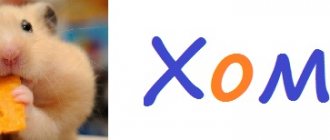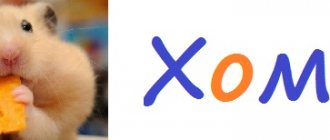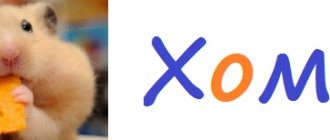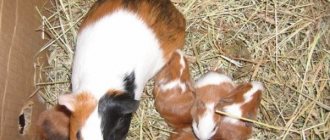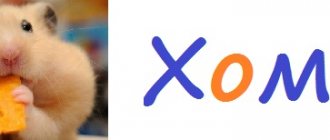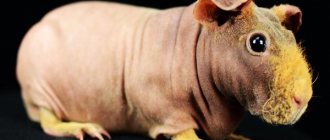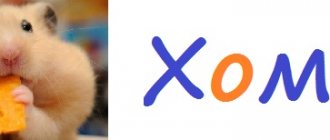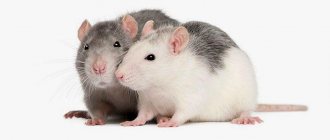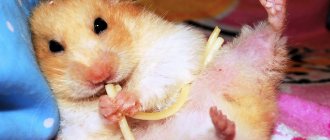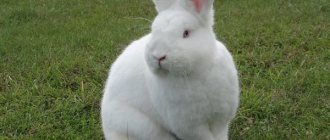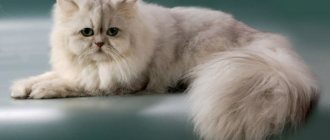- Wild animals
- >>
- Mammals
Agouti (Dasyprocta) or the golden South American hare is a medium-sized animal from the order of rodents. It happens that the animal is called a humpback hare due to its metallic color and fast running, but, despite the name, agouti is more reminiscent of a guinea pig with elongated limbs. The animal swims well and prefers to settle near water bodies. You can learn about other interesting features of the rodent from this publication.
From the history of agouti guinea pigs
Indeed, the agouti pig is a whole world. It is agouti pigs that are the ancestors of all modern breeds of guinea pigs, because it was in this form that they appeared many, many centuries ago on the shores of the Amazon, and they remain so in nature to this day. Wild guinea pigs found in South America have a lot in common with the agouti breed.
In some countries, the agouti breed has not yet received official recognition.
Agoutis are often confused with regular smooth-haired guinea pigs.
Features of agouti
The agouti guinea pig is an amazingly beautiful guinea pig, which is loved all over the world for its beautiful smooth coat of amazing color, good-natured character and high intellectual abilities.
The most important feature of these pigs is their unusual coat color, the so-called ticking, when each hair is colored in a special way: closer to the skin, the hair has a primary color, in the central part it becomes lighter, and at the tip it darkens again. This is the most common option. In general, there are three types of ticking:
- dark – basic – dark colors again;
- dark and primary colors:
- dark color without a light part.
The color of the fur on the belly corresponds to the color of one part of the hairs of the coat and contrasts with the general tone of the pig, speckling is excluded. Agouti pigs have dark eyes. Large, delicate ears that hang down and are shaped like petals.
As a rule, these pigs have a strong and strong physique. They have strong, short legs.
Reasons for the decline in the number of Mexican agoutis
The number of Mexican agoutis is declining sharply. The main reason is the reduction of the area due to human economic activity.
Recently, the number of Mexican agouti has been greatly reduced.
In addition, agouti is of interest to local hunters. Its meat can be eaten. Many animals die while visiting plantations, when people protect their crops.
Maintenance and care
Agoutis are very low-maintenance guinea pigs, so they are often recommended as a first guinea pig for both adults and children. Agouti's coat does not require as much care as the coat of long-haired guinea pigs.
All that is needed to keep an agouti optimally is a spacious cage and the right diet. You can read about how to choose a cage for your pet in the article “Cage for a guinea pig”
As for diet, like other guinea pigs, agoutis can be given an exclusively vegetarian diet - vegetables, fruits, plus fresh grass and/or hay and special pellets (dry food), which can be found at a pet store.
Regularly, at least once every couple of days, pigs should be let out of the cage to run around: in the summer, it would be good to go on the grass, in the winter, around the room. Bathing agoutis is not recommended. These pigs are very clean, and always take care of the cleanliness of their fur coat on their own.
Read more about the intricacies of caring for guinea pigs in the section “Keeping Guinea Pigs”
Social structure and reproduction
Photo: Agouti Rat
Agoutis live in stable pairs that remain together until one member of the pair dies. Sexual maturity occurs at the end of the first year of life. Often only one individual can be seen, as members of the pair are not in close contact with each other. The animals breed throughout the year, but most young are born during fruit abundance from March to July. Some species may breed several times a year in May and October, while others breed year-round.
Fun fact: During courtship, the male sprays the female with urine, which causes her to engage in a “mad dance.” After a few splashes, she allows the male to approach her.
The gestation period is 104-120 days. A litter usually contains two young, although sometimes there may be three or four. Females dig burrows for their young or lead them to old dens they have built, usually located in hollow logs, among tree roots, or under tangled vegetation. The young are born in burrows lined with leaves, roots and hair. They are well developed at birth and can start eating within an hour. Fathers are removed from the nest. The den is exactly the size of the offspring. As the cubs grow, the mother moves the litter to a larger den. Females have several dens.
Newborns are fully furred, their eyes are open, and they can run around in the first hour of life. The mother usually breastfeeds for 20 weeks. The offspring are completely separated from their mother after a new litter. This occurs due to parental aggression or lack of food. Cubs born during the fertile period have a significantly higher chance of survival than those born in the off-season.
Agouti colors
There are six types of agouti colors:
- Lemon Agouti: base color is rich black with lemon ticking. The color of the belly should be an even lemon color. Lemon agoutis have dark eyes, black ears, and black paw pads.
- Silver Agouti: the main color is rich black with silver ticking. The color of the belly should be an even silver color. No whiteness. Silver Agoutis have dark eyes, black ears, and black paw pads.
- Golden Agouti: the main color is rich black with a golden tick. The belly should be golden or even red. He has dark eyes and has black ears and pads
- chocolate agouti (Orange Agouti): the main color is a rich dark brown, chocolate with red ticking. The belly is bright red. The eyes are ruby red, the ears and pads on the paws are chocolate color.
- Cream Agouti: the base color is a rich dark brown with soft cream ticking. Stunningly beautiful combination! The belly is also cream colored, the eyes are ruby, the ears and paw pads are dark brown.
- Cinnamon Agouti: The base color is a rich cinnamon brown with silver ticking. The belly is, accordingly, silvery in color. Ruby eyes, brown ears and paw pads.
Personality of agouti guinea pigs
According to numerous personal observations of the breeders of these pigs, agoutis are the only pigs at the moment about which it can be said for sure that the breed determines their character and behavior. They amazingly combine all the tenderness for which we love them, and at the same time - all the wildness of their South American ancestors. It is agouti pigs that are distinguished by their unbridled love of freedom and craving for wild nature. They can easily live on free grazing - only in the summer, of course! And if an agouti pig hides in the grass, you won’t find it at all. Unless she herself wants to.
But at the same time, like all animals, agouti pigs have a very well developed sense of self-preservation and a sense of the state of the environment (human weather dependence). So in his endless exploration of the surrounding space, the agouti will never play too much, missing the danger.
Agoutis can sometimes be quite shy, especially when they find themselves in unfamiliar surroundings or see new people. At first, try to spend as much time as possible with your new pet so that he gets used to you.
Like other guinea pigs, agoutis appreciate company and do not like to be alone. The best option for keeping any guinea pigs is same-sex couples.
Agouti Exhibition Standards
The agouti guinea pig is very popular among breeders abroad.
These are the typical exemplary standards stated by the Agouti National Club:
- The head should be short and wide with a “Roman” profile.
- The muzzle should be fairly wide and the nostrils should be neatly rounded.
- The eyes are large, bright, located on both sides of the head.
- The ears are large, hanging down like rose petals.
- The body should be short, muscular with broad shoulders.
- Ticking should be clear and even across the head, chest, legs and body. Its color should transfer well to the skin.
- The belly should be the same color as the ticking color. The color of the belly should not be visible when looking at the pig from the side.
- The coat should be soft and silky, clean and short.
In general, one can talk endlessly about these amazing animals! As well as about multiple color options, breeding features and much, much more.
What are the characteristics of the breed?
The main characteristic of agoutis is their smooth coat. And to be more precise, its color. He is unusual. After all, each hair near the root has a color, then in the middle it becomes lighter, and the ends darken again to the real color.
This color is the most common, but there are also options when the hair comes in a dark color and then the main one, or the pig is simply dyed a dark color without a lightening part.
The fur on the belly is the same as one of the hair colors, but at the same time it also contrasts with the main color of the coat.
The agouti's eyes are dark, and its ears look like petals and hang down.
The animals also have strong short legs.
Lifestyle
Most of this rodent's time is spent searching for food or swimming in a puddle of water. When at rest, the agouti is found in a burrow or hollow tree trunk, safe from predators such as coatiundis, jaguars and ocelots. Acute hearing and a keen sense of smell help the agouti prepare when a predator is nearby: it can freeze, make an alarm cry, stomp its paws or raise the long hair on its butt to scare off the enemy.
If it needs to escape, the agouti can run quite quickly. What's even more amazing is that this rodent can jump up to 1.8m out of the air from a standing start, turn around, land and fly out in the opposite direction!
Fallen fruit is agouti's favorite food, after nuts, of course. His sensitive ears can even hear when fruits fall to the ground! Agoutis often eat in an upright position, holding food with their front legs, like a squirrel.
When there is a lot of food, the agouti buries the extra food around its territory as a reserve. His keen sense of smell helps the animal find food again in difficult times. If an agouti buries a nut and never returns to eat it, the nut may simply grow into a tree. So agouti is not a bad gardener.
How to care for agouti?
They do not require anything special to care for. Therefore, you can safely buy them as a gift for children. Their short coat does not cause any trouble.
For proper care you will need to follow some rules:
- Buy a spacious cage;
- When feeding, adhere to the diet for the animal. In fact, only provide vegetarian foods. They can eat grass and hay. They also love fruits and vegetables. There are special pellets on sale that are designed for guinea pigs. They can drink plain water.
- Let the animal run at least once every few days.
- There is no need to bathe agoutis. They are very clean and take good care of themselves.
General feeding rules
The recommended daily ratio of all types of food looks like this:
- dry food – 5-10% (no more than a tablespoon);
- juicy food – 30%;
- hay – 60%.
If there is no dry food on the menu, an adult pig should eat approximately 150 g of vegetables per day . She is served vegetables every day, and is occasionally pampered with berries and fruits. Vegetable dishes must be supplemented with leafy greens, which compensate for the lack of vitamins.
Do not keep your rodent on a mono-diet, feeding it only carrots or beets: this will cause health problems. It’s great if there are different products on his table every day: parsley will be replaced by dill/basil, and celery by carrots/zucchini. A typical daily diet consists of three types of vegetables and herbs.
Important! Do not collect plants near highways, factories, or in swampy areas. Dry the grass for at least 1.5-2 months: it should not be blackened or rotten.
Do not forget to establish an uninterrupted supply of hay (especially during the cold period): the guinea pig chews it constantly, without limiting itself in volume. Hay normalizes digestion and is necessary for proper grinding of teeth.
Legume and legume-cereal hay is considered the most valuable. The rodent will also thank you for the vitamin herbs (nettle, alfalfa and clover) that you will prepare in the summer. These plants will be an excellent feed for growing and pregnant animals.
Animal character
They are affectionate, but at the same time they retain the wildness of their ancestors. Agoutis love freedom and wild nature. Therefore, in the summer they can walk outside for a long time. And if they hide in the grass, then you may not find them.
But if a guinea pig senses danger, it will never go there. The sense of conservation is very well developed.
Agoutis are sometimes shy, so they can become nervous when they are around few people they know. In the first time after purchase, it is better to visit them more often.
Like all guinea pigs, they are sociable and love company. !!
Source
Rodents that swing
The agouti is a rodent from the tropical forests of Central and South America that resembles a very large guinea pig. His coarse hair is coated in an oily (and smelly!) substance that acts like a cloak. The hair is longest on the butt. Agoutis have five toes on their front feet and three on their back feet. It walks on tiptoes, rather than being flat-footed like many rodents, giving the agouti its graceful appearance.
Although it is difficult to see, the agouti has a tail: it is very small, like a dark jelly, stuck on the animal's buttock!
Like other rodents, agoutis have teeth designed for chewing very hard objects, with a single pair of sharp incisors at the front of the mouth. These are the teeth they use to chew tough objects like nut shells.
The layers of enamel on their teeth are twisted in a way that makes them much stronger. Brazil nuts may be difficult for us, but they are no problem for agoutis! This tough rodent is the only animal that can crack the hard outer shell of a Brazil nut. The sharp incisors continue to grow throughout their lives, ensuring that they always have nut cracking tools at the ready. Agoutis use their molars to grind food.
